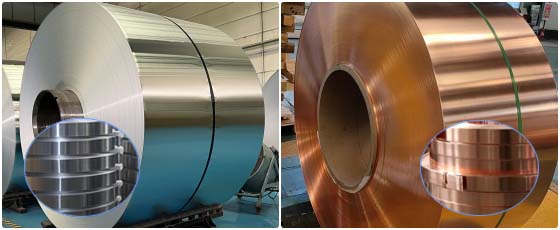- Email: sales@flait-aluminum.com
- Tel: 0086-13203837398

Currently, transformers are widely used in various electronic equipment. Transformer copper strips and aluminum strips are two common conductor materials.
There are some obvious differences between copper and aluminum in terms of physical and chemical properties, conductivity, corrosion resistance, strength and hardness, price and sustainability, and environmental protection.
When manufacturing transformers, appropriate materials should be selected according to different needs to ensure their performance and quality.
 1. Characteristics of transformer copper strips and aluminum strips
1. Characteristics of transformer copper strips and aluminum stripsCopper and aluminum have different physical and chemical properties. Copper is a heavier metal with a higher density, higher melting point, and better ability to conduct electricity. In comparison, aluminum is lighter, softer, and easier to work with, but it doesn’t conduct electricity as well as copper.
 2. Conductive properties of transformer copper strips and aluminum strips
2. Conductive properties of transformer copper strips and aluminum stripsThere are significant differences in the conductivity of copper strip and aluminum strip. Copper is one of the best conductive materials available and has extremely high conductivity properties, so it is widely used in high-power equipment and electronic equipment. In comparison, although aluminum has a lower conductivity, the price is more affordable.
 3. Corrosion resistance of transformer copper strips and aluminum strips
3. Corrosion resistance of transformer copper strips and aluminum stripsCopper and aluminum strips also differ in their corrosion resistance. Copper has very good corrosion resistance and will not rust or corrode even if it is exposed to the air for a long time. In comparison, aluminum is more susceptible to oxidation and corrosion and therefore requires special treatments to improve its corrosion resistance.
 4. Strength and hardness of transformer copper strip and aluminum strip
4. Strength and hardness of transformer copper strip and aluminum stripThere are also certain differences in the strength and hardness of copper strip and aluminum strip. Copper is a metal with high hardness, so when manufacturing a transformer, multiple processes such as heating and cooling are required to ensure its shape and performance. However, aluminum has better plasticity and toughness, making it easier to process and shape.
 5. Prices of transformer copper strips and aluminum strips
5. Prices of transformer copper strips and aluminum stripsCopper is a more expensive metal, so the cost increases accordingly when manufacturing transformers. In comparison, aluminum is more affordable.
 6. Environmental protection of transformer copper strips and aluminum strips
6. Environmental protection of transformer copper strips and aluminum stripsCopper strip and aluminum strip are both recyclable materials and are therefore widely used in environmental protection fields.
| Name | Transformer copper strip | Transformer aluminum strip |
| Density and weight | High density and heavier | Low density and light weight |
| Conductive properties | Extremely high conductivity properties | Good electrical conductivity |
| Corrosion resistance | Very good corrosion resistance | Not as good as copper strip |
| Strength and hardness | High hardness, difficult to process | Slightly low hardness, easy to process |
| Prices | More expensive | Cheap |
| Recyclability | Recyclable | Recyclable |
Original Source:https://www.flait-aluminum.com/Transformer-Aluminum-Strip.html